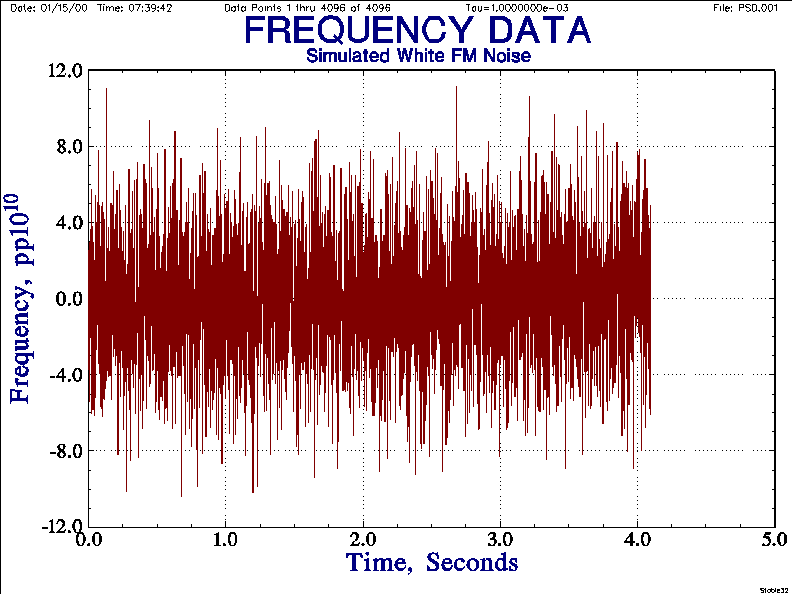
ABSTRACT
This document shows an example of a time and frequency domain stability analysis using Stable32. First, a set of simulated power law noise data is generated using the Noise function. Then the time domain properties of this noise are analyzed using the overlapping Allan deviation with the Run function. Next the same data are analyzed in the frequency domain with the £(f) Power function. Then the expected results are found with the Domain function, and compared against those obtained. Finally, the other power spectral density types are examined.
NOISE GENERATION
Choose the Noise function, and enter the desired noise parameters into the dialog box controls. For this example, we will generate 4097 points of simulated white FM noise with a 1-second Allan deviation value s(1) = 1x10-11 and a sampling interval t = 1 msec. Pressing OK will generate and display a set of phase and frequency noise data having those parameters (each set will be different). The number of points is chosen as an even power-of-2 for the frequency data.
DATA PLOT
Use the Plot function to display the generated set of simulated white FM noise as frequency data. The plot is enhanced by using several of the plotting options.

TIME DOMAIN ANALYSIS
Choose the Run function, select the overlapping variance type and press Calc to begin the analysis. A table of time-domain stability data will be generated. Click on the Lines button, select the Noise line type, and accept the default W FM noise slope by pressing OK. If desired, use the Options button to label the plot with a subtitle "Simulated White FM Noise". Then press the Plot button to produce a stability plot that includes a W FM power-law noise fit. The s(1) fit parameter is 1.08e-11, close to the desired value.
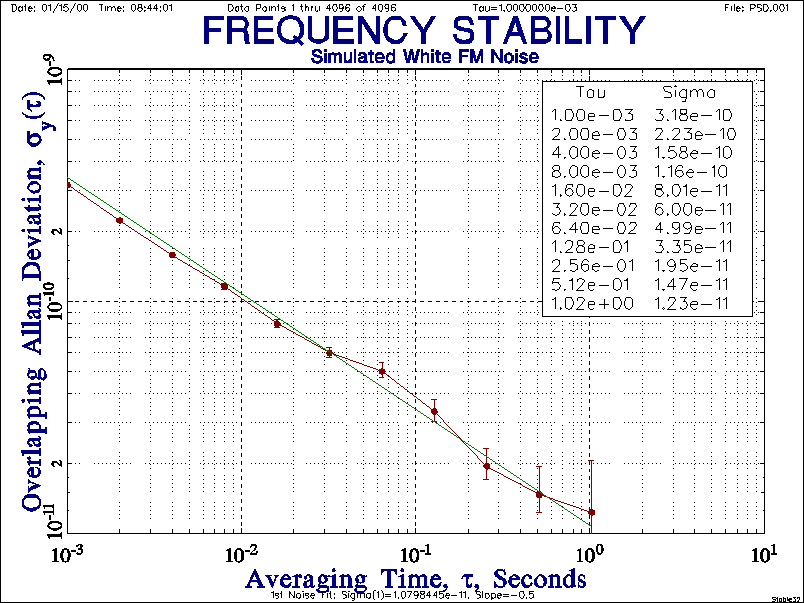
FREQUENCY DOMAIN ANALYSIS
Choose the Power function and calculate a power spectrum for the phase data, using the default 10 MHz carrier frequency and £(f) power spectral density type, the SSB phase noise to signal ratio in a 1 Hz BW as a function of sideband frequency, f. Press Plot to produce a PSD plot that includes a smoothed fit using octave-band averages. The fit parameters show an £(1) value of –79.2 dBc/Hz and a slope of –19.6 dB/decade, in close agreement with the expected values of –80 dBc/Hz and –20 dB/decade, as shown in the following paragraph.
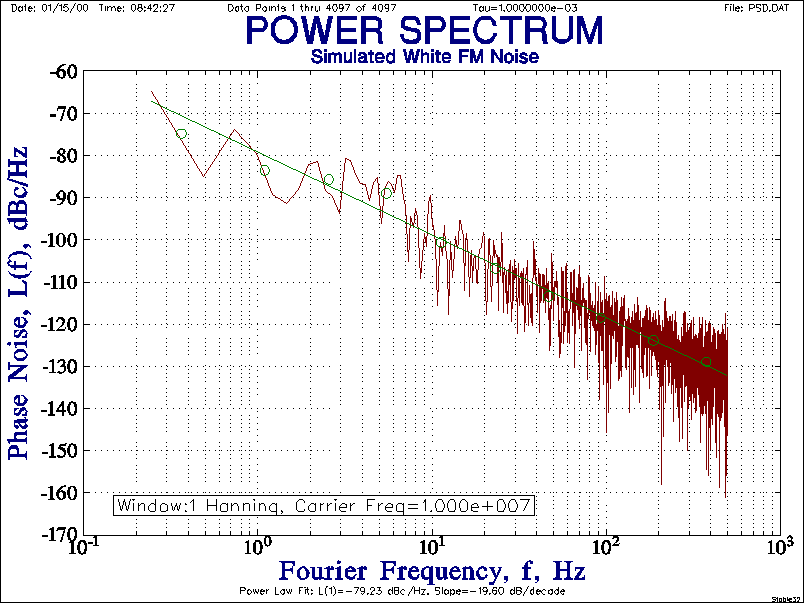
DOMAIN CONVERSION
The Stable32 Domain function can be used to determine the PSD values that correspond to the time domain parameters that were used to generate the simulated power-law noise. Press Domain and enter those parameters. Use the normal sigma and enter its 1-second value as 1e-11 with tau =1e-3 and an averaging factor of 1000. Choose the £(f) PSD type, a 1 Hz sideband frequency, and use the default 10 MHz carrier frequency. The resulting £(1) value is –80 dBc/Hz, and white FM noise has a slope of –20 dB/decade.
Domain Calculation Results:
Frequency Domain Time Domain
PSD Type: L(f), dBc/Hz Sigma Type:
Normal
SB Freq (Hz): 1.00000e+00
Tau (Sec): 1.00000e-03
Carrier(MHz): 1.00000e+01 Avg Factor: 1000
Power Law Noise
Type dB/dec PSD Type Mu
Sigma
RWFM -40:
None RWFM +1: 0.00000e+00
FFM -30: None
FFM 0: 0.00000e+00
WFM -20: -80.0 WFM -1:
1.00000e-11
FPM
-10: None FPM -2: 0.00000e+00
WPM 0: None
WPM -2: 0.00000e+00
All -80.0 All 1.00000e-11
OTHER SPECTRAL TYPES
Stable32 supports several other types of PSD that are commonly used for
the analysis of frequency domain stability analysis. These are S*(f), the
spectral density of the phase fluctuations in rad2/Hz, Sx(f), the spectral
density of the time fluctuations in sec2/Hz, and Sy(f) the spectral density of
the fractional frequency fluctuations in units of 1/Hz.. Tthe Domain
function can also be used to determine the expected value of all these
quantities for the simulated white FM noise parameters with s(1) = 1e-11, t = 1e-3, and
fo = 10 MHz as shown in the following table.
| PSD Type | £(f), dBc/Hz | Sf(f), rad2/Hz | Sx(f), sec2/Hz | Sy(f), 1/Hz |
| Data Type | Phase | Phase | Phase | Frequency |
| Simulated Value | -80 | 2e-8 | 5.066e-24 | 2e-22 |
| Log Value | same | -7.70 | -23.3 | -21.7 |
| Slope, dB/decade | -20 | -20 | -20 | 0 |
| Fit Value | -79.2 | 1.19e-8 | 3.03e-24 | 1.40e-22 |
| Fit Exponent | -1.96 | -1.96 | -1.96 | -0.04 |
These spectral densities are shown in the plots below:
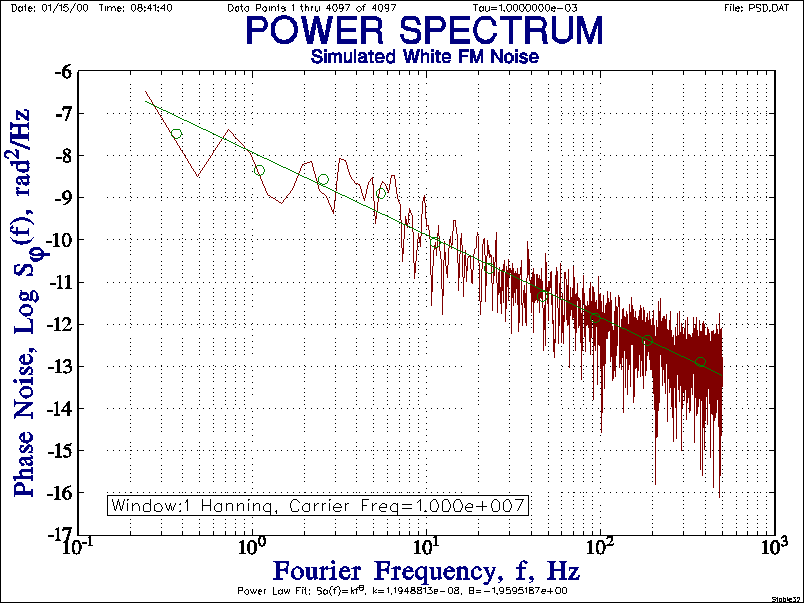
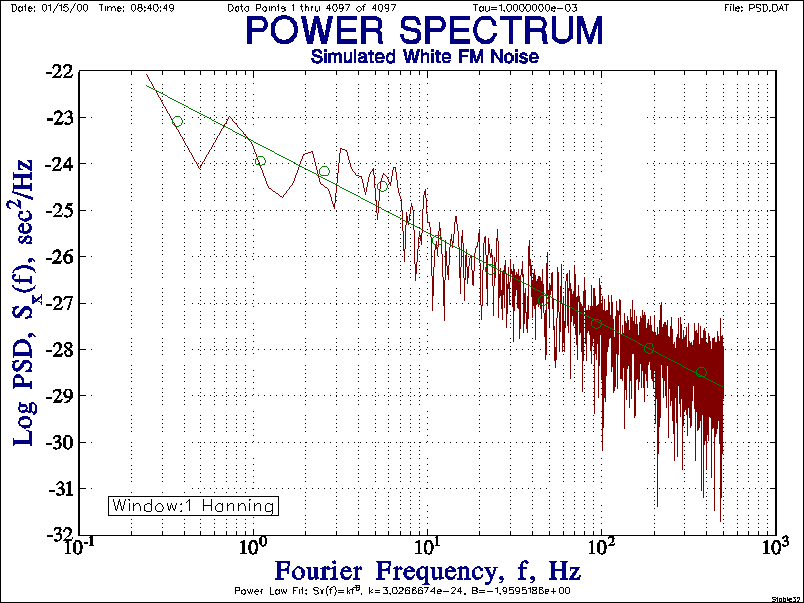
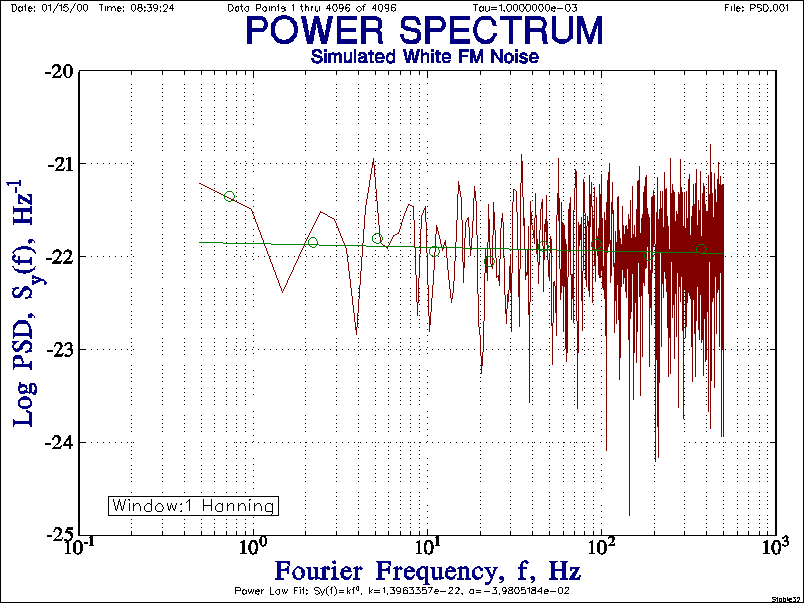
Last Rev. 1/15/00